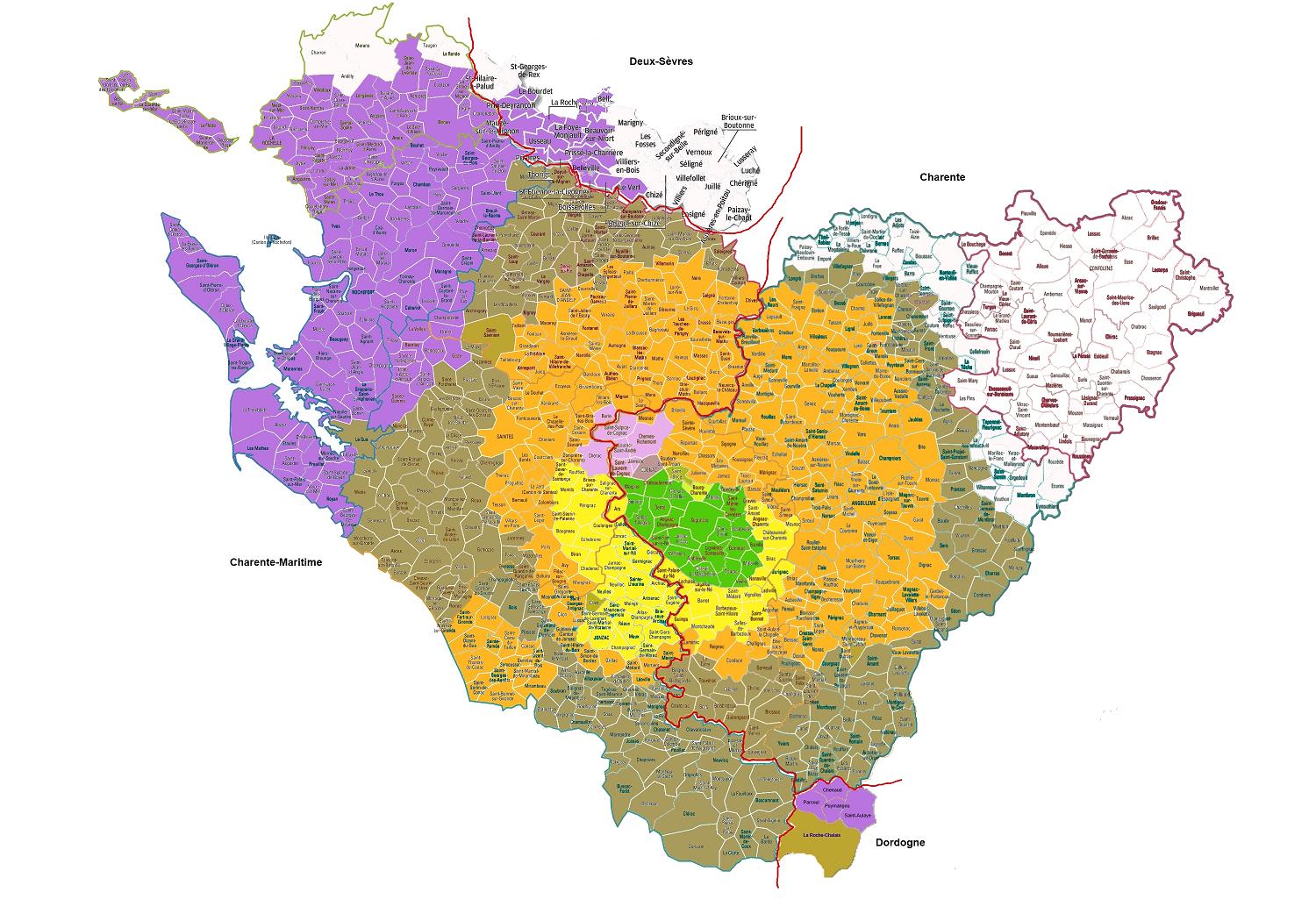The cognac region is in the Charente region, but that is an inaccurate designation. The Charente region is so named because the river Charente flows through it, and there are two departments named after it: Charente and Charente Maritime. Charente Maritime is on the coast and Charente is east of Charente-Maritime. There are also two small areas of two other departments where cognac may be made, namely in the south of Deux-Sèvres, which is north of Charente-Maritime, and to the very south a small part of the Dordogne department.
(Voor meer details: onder op de pagina staan linkjes naar deelgebieden.)
As the image clearly shows, there are also five communes in northern Charente-Maritime and a much larger number in northern Charente that do not belong to the cognac region. They are coloured white.
Other specifics:
Grande champagne
- Grande champagne lies in its entirety in the department of Charente
- The municipality of Cognac belongs in part to the Grande champagne and in part (the part above the Charente river) to the Borderies (different colour green)
- Two other communes of the Grande champagne – Bourg-Charente and Saint-Brice – do not belong to it as a whole either. The part of Bourg-Charente that lies above the Charente river belongs to the Petite champagne and the part of Saint-Brice that lies above the Charente river belongs to the Fins bois (different colours). So there is a very small area of Petite champagne just above the Charente river, above Grande champagne.
Petite Champagne
- Petite Champagne is spread across the two departments of Charente and Charente-Maritime.
- There are two communes that are not entirely Petite champagne: the commune Bourg-Charente (the southern part below the river is Grande champagne) and the commune Clam which belongs partly to the Fins bois (the part southwest of the D142). (different colours on the map).
Borderies
- The Borderies is also spread across both Charente departments: 2 communes in Charente-Maritime and 6 in Charente, of which one – the commune of Cognac – is partly Grande champagne (the part below the river; different colour).
Fins bois
- The Fins bois region consists of three distinct areas: the ring around Grande champagne, Petite champagne and Borderies; the area bordering the Gironde; and a small enclave consisting of one commune, Vaux-Lavalette, to the east (the small sweep on the map)
- The Fins bois is almost entirely surrounded by the Bons bois. There are three places where the Fins bois touches the extreme edge of the cognac region: to the north, the three communes of Chives, Les Gours and Saint-Fraigne; to the east, Vaux-Lavalette; and to the south-west, the area bordering the Gironde
- There are three communes in the Fins bois that do not belong to Fins bois as a whole: Sainte-Brice: the part south of the Charente river is Grande champagne; Saint-Savinien in the west: the part that used to be the commune of Coulonge-sur-Charente belongs to Fins bois, the western part to Bons bois; Montmoreau-Saint-Cybard in the south-east: the part that used to be the commune of Saint-Cybard belongs to Fins bois, the other part is Bons bois (different colours on the map).
Bons bois
- The Bons bois is located in three different departments: Charente, Charente-Maritime and Dordogne.
- In the Dordogne department is the municipality of La Roche-Chalais, of which only the part that used to form the municipality of Roche-Chalais belongs to the Bons bois and the other, eastern part, to the Bois Ordinaires (different colour on the map).
- Other communes partly belonging to the Bons bois are Montmoreau-Saint-Cybard (northern part is Fins bois) and Saint-Savinien (the eastern part is Fins bois).
Bois ordinaires
- Bois ordinaires have also been entitled to an appellation (appellation bois ordinaires controlée or bois à terroir controlée) for several years and are also spread over three departments: the vast majority are in Charente-Maritime. The other two parts are in Deux-Sèvres and Dordogne.
- There is one municipality in the Dordogne department that partly belongs to the Bons bois: La-Roche-Chalais.
- There are three islands in Charente-Maritime, all belonging to the Bois ordinaires: Ile de Ré, Ile d’Oléron and Ile d’Aix.
- Strictly speaking, there is a fourth island that also belongs to the Bois ordinaires: Ile Madame which is attached to the mainland by a ‘cow path’. The path can only be used at low tide. As far as we know, there is no vineyard there.
For people who feel the need to better read the municipal names, I have created partial maps:
- Western part and islands
- Upper-left part
- Northern Fins bois
- Central with Grande champagne, Petite champage and Borderies
- Southern part
- Eastern part

